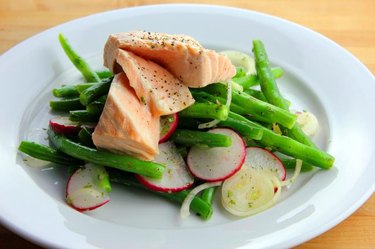
Unfortunately, a flat, toned stomach doesn't simply appear on its own — it takes hard work, along with an extra-healthy diet, to achieve a taut tummy.
However, if you've procrastinated on your workouts and spent one too many nights diving into the cookie jar, you can take measures to make your stomach appear flatter within a few days. For your health's sake, though, go further and employ long-term strategies to slim out your midsection.
Video of the Day
Video of the Day
Short-Term Solutions
When you need a slimmer stomach for an upcoming event, you can work to decrease bloating and improve your posture. However, these strategies won't make your stomach appear flatter for the long run.
Banish Bloating
When your belly is bloated, feeling uncomfortably full or gassy, it might also be visibly swollen. The condition can stem from myriad conditions, from indigestion to gallstones — so you might want to talk to your primary care doctor if it's a regular occurrence — but it can sometimes be tempered by some changes in dietary habits.
- Chew your food thoroughly before eating it. When you eat too fast, you're more likely to swallow air, which leads to bloating. Additionally, your body works harder to break down unchewed food, which can ramp up gas or indigestion.
- Watch for triggers. Some people bloat when they eat certain foods, particularly those known as FODMAPS — Fermentable Oligo-Di-Monosaccharides and Polyols — can cause gas, bloating and cramping. These include fruits, honey, dairy, wheat, garlic, onion, soybeans, beans, lentils, stone foods and sweeteners including isomalt, mannitol, sorbitol and xylitol.
- Shy away from carbonated drinks and chewing gum. These, too, can increase the amount of air you swallow, leading to a puffy belly.
Warning
Certain FODMAPS foods are high in fiber, important for colon health. Only omit foods from your diet that you know to trigger bloating. You can also built up tolerance by adding a half-cup or less of these foods and drinking plenty of fluids.

Stay Hydrated
Piggybacking off reducing bloating, staying hydrated helps prevent water retention and, therefore, can give you the appearance of a flatter stomach. When you don't drink enough water, your kidneys hold onto fluids; this causes puffy skin and bloating.
Double-check your urine to verify that you're drinking enough water. It should a very pale yellow; a dark yellow color means you need to up your water intake.
Check Your Posture
It might not have much to do with nutrition, but proper standing and sitting posture can make your stomach appear flatter. As a bonus, it can also improve your confidence levels, according to Palmer College of Chiropractic. Take these steps to better posture:
- Stand with your feet shoulder-width apart, with your toes pointing straight ahead — rather than inward or outward. Keep your weight evenly distributed on both feet.
- Put your spine in a neutral position; you should have a slight curve in your lower back. Refrain from tipping your pelvis forward, exaggerating the lower back's curve, or backward. Both positions can lead to low back pain.
- Position your head up and back, keeping your eyes gazing toward the horizon.
- Keep your core muscles engaged to support your spine.
Long-Term Strategies
If you want to make your stomach appear flatter for more than just a day or two, you must put in the work that decreases body fat and increases muscle definition.
Add Circuit Training to Your Routine
Sad as it might seem, it takes more than sit-ups and crunches to slim your waistline. Instead, incorporate intense cardio activity into your workout routine to burn calories, boost your heart rate and shed belly fat.
Fitness expert Jillian Michaels recommends circuit training — that is, a combination of strength-training and/or cardiovascular exercises that are performed one right after each other, without a significant break in between.
When you complete one rotation of approximately four to five moves — which is what Jillian recommends, though you can modify it higher or lower as needed — you return to the beginning and repeat the circuit. This form of exercise raises your heart rate and affects your whole body, not just one small part.
Some exercises you can include in your circuit training include:
- Upper body: Bench dips, bench lift, press-ups
- Lower body: Squat jumps, steps ups
- Full-body: Burpees, squat thrusts
- Core: Crunches, planks

Incorporate Pilates
Once you've shed body fat via a healthful diet and cardiovascular exercise, Pilates can help strengthen your abdominal muscles to make your stomach appear flatter.
Pilates, a series of 25 to 50 exercises meant to strengthen your core done one right after one, can help build muscle and improve your posture, a two-fold benefit when it comes to making your stomach appear flatter.
In addition to the stomach muscles, Pilates works your lower back, hips and thighs. A study published in 2007 in the Journal of Bodywork and Movement Therapy concluded that Pilates exercises positively affects abdominal strength and endurance.

Boost Protein, Decrease Simple Carbs
A nutritional plan that promotes a lean stomach focuses on vegetables and lean proteins, with a moderate amount of quality fat and carbohydrate sources.
A study published in 2008 in the scientific journal Obesity concluded that bumping up your protein intake to 35 percent of your macronutrient ratio and eating more frequently throughout the day — six times, to be specific — decreased belly fat more effectively than the current macronutrient recommendation of 10 percent to 35 percent eaten during three meals per day.
Ways to add more protein to your diet include eating eggs at breakfast, enjoying low-fat yogurt for a snack, adding beans to your salad at lunch — provided they don't cause you to bloat — and planning grilled or baked chicken or fish for dinner.
Although carbohydrates have been much maligned as a healthful food, research from the Pennsylvania State University found that participants that ate whole grains lost twice as much weight as those who didn't eat any.
Whole grains impact the production of insulin, says the study, lowering it so your body doesn't store as much fat. Healthful whole grains include brown rice, whole-wheat bread and oats.